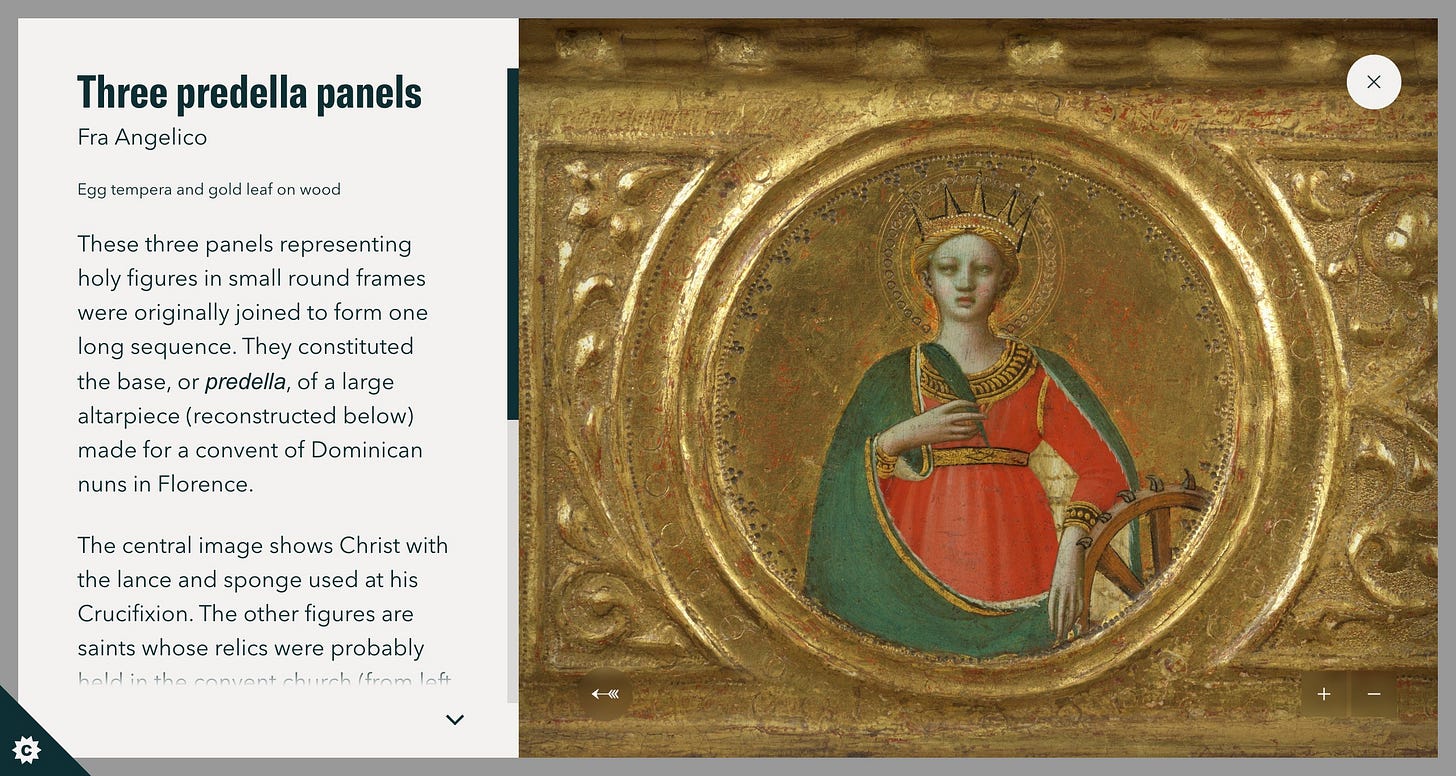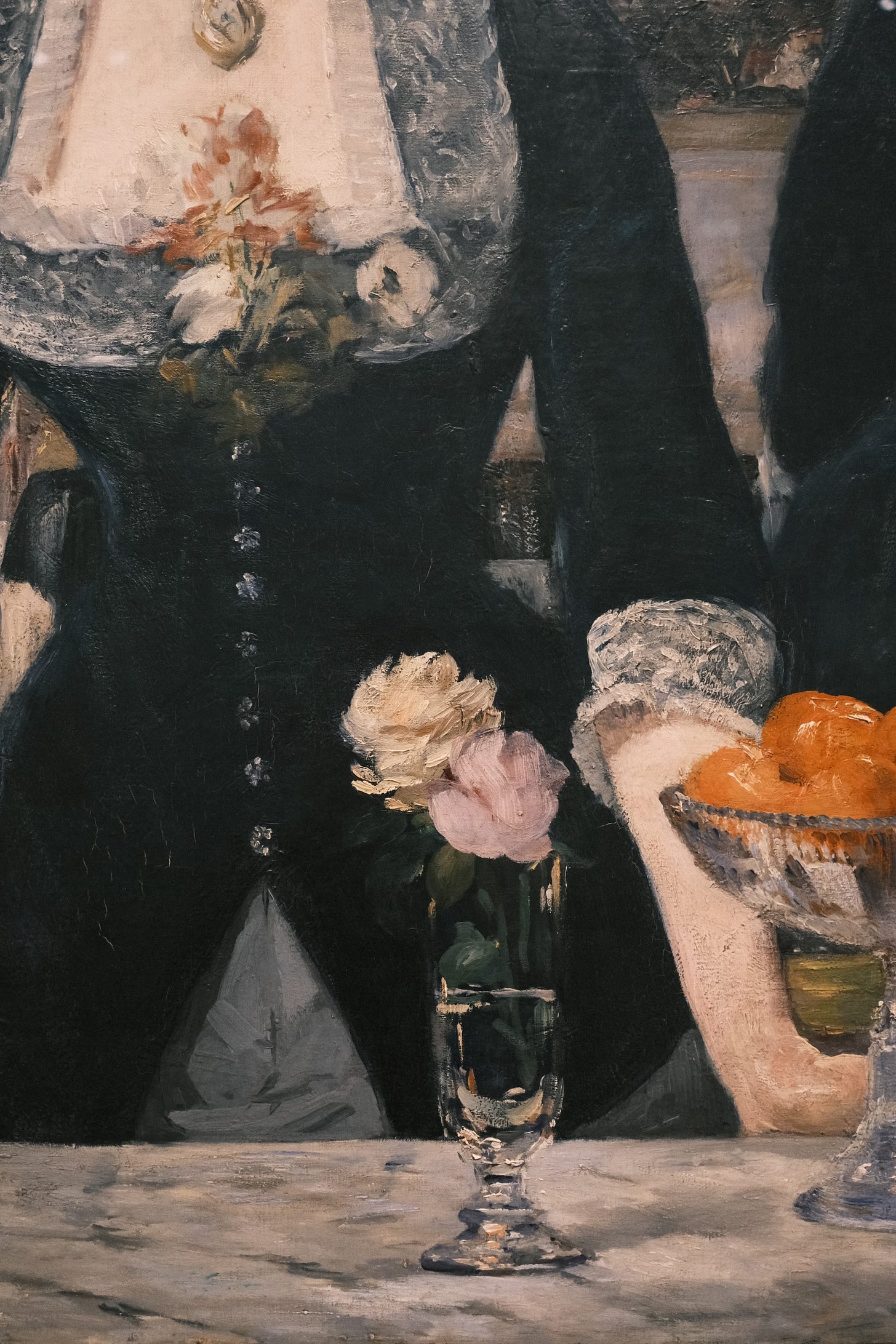An Afternoon at The Courtauld in London
And thoughts on accessibility. Should museums be free to visit? Plus a poem inspired by my visit to the gallery.

I love it when social media gets targeting right. A few weeks ago, I was shown a reel from Jackson’s Art Supplies on Instagram. The video features artist Evie Hatch, who’s a Materials Specialist at Jackson’s, explaining the history behind the pigment ‘Caput Mortuum’. I recommend you see all her videos on the different pigments, they’re fascinating.
After watching the videos I got caught in the middle of an upward spiral that led me to The Courtauld Gallery. Fourteen years in London and I never heard of it!? I had to make up for lost time so I blocked a whole Saturday afternoon in my calendar in anticipation.
The gallery spans across three floors plus an underground level for the shop and restrooms.
On the first floor, you can find Medieval and Early Renaissance (1250-1450) works, most of which “were made to inspire devotion and prayer, in churches and at home.”1 Here you can see ‘Three predella panels’ by Fra Angelico. These caught my eye after seeing Evie Hatch talk about a painting technique called verdaccio. Watch it here.
“Have you ever noticed that people in Early Renaissance paintings look like they’re about to throw up?
A popular technique for painting flesh tones in the Early Renaissance was to do an underpainting of Green Earth [pigment], a technique called verdaccio, and then glaze a Red Lake over the top of that, which is a pigment that is made using a dye.
Even though they knew that these Red Lake glazes weren’t very lightfast, Red Lakes were incredibly useful because, unlike other pigments, they are very, very transparent and perfect for glazing techniques. And what’s happened over time is that the Red Lake glaze has faded because it is a very fugitive pigment and when that happens, what you are left with is that really, really lightfast Green Earth underpainting. And that’s what gives them that kind of sickly hue.”
— Evie Hatch for Jackson’s Art Supplies2
The second floor houses works from the Early Renaissance (1400-1500), Italian and Northern Renaissance (1500-1600), selected works from Peter Paul Rubens and 18th-century European objets d’art.
You must, however, make sure you look up when visiting the different rooms on this floor. The ceilings are just as magnificent as the works themselves.
On the top floor (my favourite), you’ll find one of the finest collections of Impressionism (1860-1880) and Post-Impressionism (1880-1900) works in the world. Featuring paintings and sculptures by Paul Cézanne, Édouard Manet, Camille Pissarro, Edgar Degas, Pierre-Auguste Renoir, Henri de Toulouse-Lautrec, Vincent Van Gogh and more.
“This collection was assembled by the textile industrialist Samuel Courtauld (1876-1947) with the encouragement of his wife, Elizabeth Courtauld (1875-1931), herself a passionate supporter of classical music. The couple started collecting in the 1920s, at a time when the artistic establishment in the United Kingdom was hostile towards modern French art. The Courtaulds' championing of Impressionism and Post-Impressionism forever changed public taste. In 1932, after his wife's death, Samuel co-founded The Courtauld Institute of Art as a teaching institution and gallery, ensuring that their extraordinary collection would be widely enjoyed.”
— The Courtauld Gallery
I don’t want to spoil the whole collection for you, you can of course see it all for free through the virtual tour, or visit the gallery in person. Tickets cost £12 on weekends and £10 on weekdays, concessions available.
Should museums be free to visit?
I usually come out of museums, frazzled, with a nervous eye tick and a deep dislike for people in general. But this time something was different. Ahhhhh! Now it makes sense.
The gallery was pretty quiet for a Saturday afternoon, with no screaming kids running around, no tourists cutting in front to take a picture of a painting to then leave without even looking at it (really?). This crowd was respectful of everyone else’s time and space and I loved that. It was so refreshing it prompted me to ask myself, “Should museums be free to visit?”.
Personally, I find the UK’s accessibility to art commendable. The cities I’ve been to in Europe so far have a strict “you want in, you have to pay” system.
But let’s dive in a bit deeper.
And a disclaimer that these are my views on this subject and prone to sound like I’m generalising when I’m very aware not everyone consumes art in this way.
I got the impression (😉) that the visitors who were at The Courtauld that Saturday afternoon wanted to be there. They planned to be there and made a conscious effort to be present because they had to pay to get in and I don’t imagine they’ll be going back every weekend, not in this economy at least!
I have come to notice there’s a tendency to trivialize things that are free. “Because I can visit the National Gallery whenever I want to, I don’t really take the time to actually ask myself, should I visit the National Gallery? What is on display there that I would really like to see?”. Some visitors, locals and tourists alike will wander through the rooms of all these free-to-enter museums without having asked themselves these questions but rather to tick a box. This leads us to packed rooms full of people, some of whom might not want to be there in the first place, creating chaos for everyone involved.
Perhaps if museums weren’t free to visit, we’d all appreciate the opportunity to be in front of these works of art just a little bit more. Just because you have to pay, you’ll look a bit longer and you might, just might be lucky enough to see beyond the works. Even if you don’t understand them right there and then, even if you don’t like them or feel like they’re overrated or loved one as you’ve never loved a piece before without being able to explain why.
Someone before our time put brush to canvas and made something out of nothing, they created from within, from pain, love or sadness and it struck a chord so much so that it spoke to so many people on a personal level, that demands respect.
26.08.23
The more you look, the more you see, the more you see, the more you understand. The works begin to shed, one layer at a time, revealing themselves, to those who seek.
The Courtauld gallery is open Monday to Sunday from 10.00 to 18.00 (last entry 17.15). Somerset House, Strand, London WC2R 0RN.







